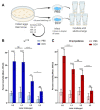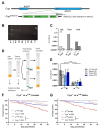Physical and Chemical Barriers in the Larval Midgut Confer Developmental Resistance to Virus Infection in Drosophila
- PMID: 34065985
- PMCID: PMC8151258
- DOI: 10.3390/v13050894
Physical and Chemical Barriers in the Larval Midgut Confer Developmental Resistance to Virus Infection in Drosophila
Abstract
Insects can become lethally infected by the oral intake of a number of insect-specific viruses. Virus infection commonly occurs in larvae, given their active feeding behaviour; however, older larvae often become resistant to oral viral infections. To investigate mechanisms that contribute to resistance throughout the larval development, we orally challenged Drosophila larvae at different stages of their development with Drosophila C virus (DCV, Dicistroviridae). Here, we showed that DCV-induced mortality is highest when infection initiates early in larval development and decreases the later in development the infection occurs. We then evaluated the peritrophic matrix as an antiviral barrier within the gut using a Crystallin-deficient fly line (Crys-/-), whose PM is weakened and becomes more permeable to DCV-sized particles as the larva ages. This phenotype correlated with increasing mortality the later in development oral challenge occurred. Lastly, we tested in vitro the infectivity of DCV after incubation at pH conditions that may occur in the midgut. DCV virions were stable in a pH range between 3.0 and 10.5, but their infectivity decreased at least 100-fold below (1.0) and above (12.0) this range. We did not observe such acidic conditions in recently hatched larvae. We hypothesise that, in Drosophila larvae, the PM is essential for containing ingested virions separated from the gut epithelium, while highly acidic conditions inactivate the majority of the virions as they transit.
Keywords: Drosophila; antiviral mechanisms; dicistrovirus; gut pH; larval development; midgut; peritrophic matrix.
Conflict of interest statement
The authors declare no conflict of interest.
Figures





Similar articles
-
Infectivity of Drosophila C virus following oral delivery in Drosophila larvae.J Gen Virol. 2015 Jun;96(Pt 6):1490-1496. doi: 10.1099/vir.0.000068. Epub 2015 Jan 27. J Gen Virol. 2015. PMID: 25626683
-
Drosophila C virus systemic infection leads to intestinal obstruction.J Virol. 2014 Dec;88(24):14057-69. doi: 10.1128/JVI.02320-14. Epub 2014 Sep 24. J Virol. 2014. PMID: 25253354 Free PMC article.
-
Wolbachia-mediated antiviral protection in Drosophila larvae and adults following oral infection.Appl Environ Microbiol. 2015 Dec;81(23):8215-23. doi: 10.1128/AEM.02841-15. Epub 2015 Sep 25. Appl Environ Microbiol. 2015. PMID: 26407882 Free PMC article.
-
Epithelial ultrastructure and cellular mechanisms of acid and base transport in the Drosophila midgut.J Exp Biol. 2009 Jun;212(Pt 11):1731-44. doi: 10.1242/jeb.029306. J Exp Biol. 2009. PMID: 19448082 Review.
-
The diversity of insect antiviral immunity: insights from viruses.Curr Opin Microbiol. 2016 Aug;32:71-76. doi: 10.1016/j.mib.2016.05.002. Epub 2016 May 24. Curr Opin Microbiol. 2016. PMID: 27232381 Free PMC article. Review.
Cited by
-
Regulating metabolism to shape immune function: Lessons from Drosophila.Semin Cell Dev Biol. 2023 Mar 30;138:128-141. doi: 10.1016/j.semcdb.2022.04.002. Epub 2022 Apr 16. Semin Cell Dev Biol. 2023. PMID: 35440411 Free PMC article. Review.
-
Increased environmental microbial diversity reduces the disease risk of a mosquitocidal pathogen.mBio. 2024 Jan 16;15(1):e0272623. doi: 10.1128/mbio.02726-23. Epub 2023 Dec 6. mBio. 2024. PMID: 38055338 Free PMC article.
-
The Intestinal Immune Defense System in Insects.Int J Mol Sci. 2022 Dec 1;23(23):15132. doi: 10.3390/ijms232315132. Int J Mol Sci. 2022. PMID: 36499457 Free PMC article. Review.
-
Pathogenicity of La Jolla Virus in Drosophila suzukii following Oral Administration.Viruses. 2022 Sep 30;14(10):2158. doi: 10.3390/v14102158. Viruses. 2022. PMID: 36298712 Free PMC article.
References
Publication types
MeSH terms
Grants and funding
LinkOut - more resources
Full Text Sources
Medical
Molecular Biology Databases
Research Materials

